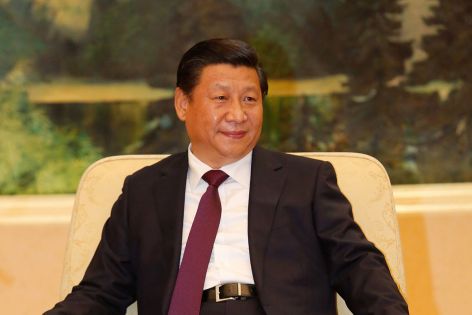Xi Jinping: Another Strongman Arises in the East
Throughout the past year, the world has focused on Vladimir Putin and a resurgent Russia. But another strongman is rising in the east. Meet China’s Xi Jinping.

But there is another political leader in Eurasia that our readers should be aware of: Xi Jinping.
Xi Jinping is the general secretary of the Communist Party of China—which puts him at the head of the ruling Communist hierarchy in China. Currently this position can be equated with what has sometimes been referred to as China’s “paramount leader.”
Xi Jinping’s leadership has deviated sharply from his immediate predecessors. Mao Zedong’s authoritarian and oppressive leadership is well documented.
After Mao’s death, his successor, Deng Xiaoping, moved China away from Mao’s leadership style to a concept known as “collective leadership.” Under this model, power was divided among the different leaders of the party. Post-Mao leadership has also been less charismatic—as opposed to the personality cult engendered by Mao Zedong.
But that is changing with the ascent of Xi Jinping, who is entering his third year in power.
Xi Jinping’s goal is very similar to that of Vladimir Putin—to be a counterweight to American geopolitical power.
Xi Jinping’s new approach
Many in China have been waiting for another strongman to arise in the spirit of Mao—someone who has the strength and tenacity to rein in corruption, strongly deal with the parts of China prone to dissent (such as Hong Kong), and lead China into a new era of international dominance.
Enter Xi Jinping.
Xi Jinping has risen to the post of “paramount leader” of China from a group known as the “Red Second Generation”—the children of the founders of Communist China. As opposed to capitalists and other technocrats, the “Second Reds” represent believers in the hard-line communist principles who see Western values and influence as a core threat to China. Xi Jinping has already gone after moderate reformers in China, often under the guise of rooting out corruption.
According to Harvard China scholar Roderick MacFarquhar, “Xi has ‘obsessively’ worried about how the Soviet Union fell under Mikhail Gorbachev and does not want the same corrosive free expression to topple China” (“China Unveils Its Own Hard-Line ‘Putin,’” Christian Science Monitor, Nov. 17, 2014, p. 23).
A major example of this is Mr. Xi’s characterization of anything Western as a “hostile force” trying to topple Communism. This is how Xi’s Communist Party has characterized the recent pro-democracy demonstrations in Hong Kong. Last year, a leaked internal memo listed seven Western values and institutions that China must battle, “including constitutional democracy, media independence, civil society and market liberalism” (“The Power of One,” Time, Nov. 17, 2014, p. 44).
The New York Times recently reported: “Signs of Mr. Xi’s ascendancy are everywhere, from the collections of his speeches selling in bookstores to the intense, often adulatory, news coverage of his busy routine. In lighter moments, the state-run news media have taken to calling him ‘Xi Dada’: roughly, Big Papa Xi.”
The similarity of Xi Jinping’s approach and actions to Vladimir Putin has not been missed in the Western press. It is striking that the world now essentially sees two charismatic strongmen leading two of the most powerful nations on earth—who just happen to be neighbors!
A power shift east
The similarities between Xi Jinping and Vladimir Putin run much deeper than just their leadership styles. Xi Jinping’s goal is very similar to that of Vladimir Putin—to be a counterweight to American geopolitical power.
In addition to battling Western values in China, Xi Jinping has also been taking steps to shift power away from the West by strengthening Chinese/Russian relations. Of course, he has a willing partner in Vladimir Putin. As leader, Xi Jinping’s first trip outside of China was to visit Russian President Putin in Moscow in March 2013. This was obviously a major symbolic move that showed China’s intention to create a power alliance with Russia and to express solidarity with Putin’s approach of challenging Western power.
A recent Foreign Affairs article explained that China and Russia are “motivated less by shared material interests than by a common sense of national identity that defines itself in opposition to the West and in support of how each views the legacy of traditional communism.”
Xi Jinping “backs Russia’s pro-Syrian stand in the UN Security Council and has refused to condemn Russia’s territorial incursions in Crimea and eastern Ukraine” (“Showing Off to the World,” The Economist, Nov. 8, 2014, p. 47).
Russia and China standing together on the world scene provides a major counterweight to the United States and strengthens the position of the East. Russia and China are also two of five nations permanently on the United Nations Security Council, and they often use their veto power to check the desires of France, the United Kingdom and the United States.
China is also widening its power in Asia by creating a regional security group (patterned after NATO) called the Shanghai Cooperation Organization (SCO), composed of China, Kazakhstan, Kyrgyzstan, Russia, Tajikistan and Uzbekistan. This group intends to expand, with India, Pakistan and Iran interested in joining. The SCO holds joint military exercises and is one of many China-led national groupings that have two common features: China is the dominant member, and the United States is absent.
The Economist recently analyzed this development as China’s attempt to build a Pax Sinica: “China is not just challenging the existing world order. Slowly, messily and, apparently with no clear end in view, it is building a new one” (“Pax Sinica,” The Economist, Sept. 20, 2014, p. 39).
But even while Xi Jinping’s China has been trying to bring Asiatic nations together, he has also been flexing his muscle in the region when it comes to its continued claims over the two primary bodies of water that surround it: the East China Sea and South China Sea. Recent actions claiming ownership of parts of these seas has angered such neighbors as the Philippines, Vietnam, Japan and South Korea.
The return of geopolitics
The first 13 years of the 21st century have clearly demonstrated that we have not reached the “end of history”—the theory that the triumph of democracy and Western ideals would end international conflict as a dominant historical theme. History is not over—and international competition, conflict, corruption, terrorism, strongman leadership, tyranny and war are still dominating the world stage. Democracy and Western values have not brought world peace or triumphed around the globe. Old-fashioned realism is still alive and well as nations vie for resources, territory and control.
The common denominator of recent world problems was identified in a recent Foreign Affairs article by Walter Russell Mead, titled “The Return of Geopolitics.” He said many nations see the United States as the “chief obstacle” to the goals of their nations and power blocs. The rise of strongmen in power around the world makes a world no longer dominated by America a very dangerous proposition.
The Bible prophesies an end-time world scene characterized by world conflict: “For nation will rise against nation, and kingdom against kingdom” (Matthew 24:7). It is very significant that we continue to see much of the world controlled by strongmen.
The Bible indicates that a great power will arise out of the east, sporting an army of “two hundred million” (Revelation 9:16) that will come into conflict with Europe—which will also be led by a strongman. It seems likely that this Asiatic power will be led by an alliance between Russia and China.
Continue watching the rise of Russia and China as they seek to increase their influence around the world.
For more insight into Asia and its role in Bible prophecy, read the following resources:
Photo by Michel Temer/Global Panorama/CC BY-SA 2.0
Date Posted: November 19, 2014

 by Erik Jones
by Erik Jones

